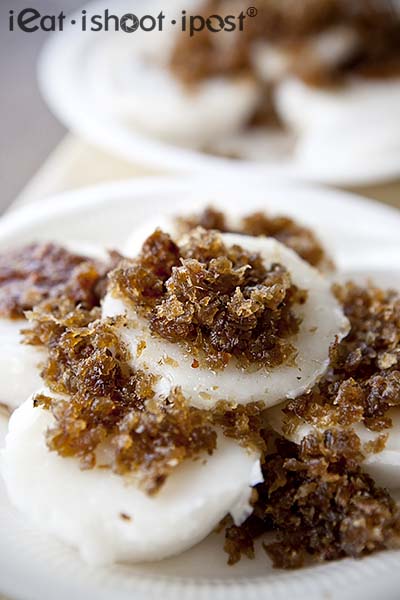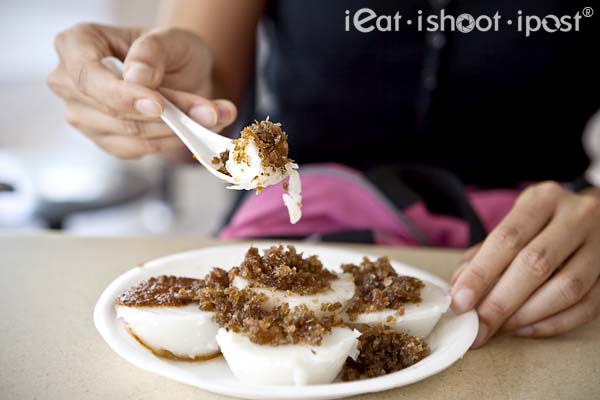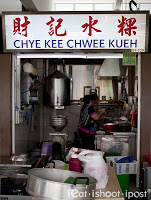I never thought I would ever get to eat Chwee Kueh which is freshly milled from broken rice! When I blogged about Ghim Moh Chwee Kueh in my last post, I thought I was already quite fortunate to be able to find an Uncle who still made Chwee Kueh himself rather than buying them from the factory. So when Uncle Smart alerted me to this particular Chwee Kueh stall in Macpherson, we had to summon the ieat brigade to go check it out.
Yes, it is true. Chwee Kueh is made from rice. I guess this is something the younger generation of Singaporeans (myself included) may not have realised because we don’t see hawkers making stuff like Chwee Kueh, Noodles or Kway Teow nowadays. All these processes are now largely done in factories. However, I do hope that one day we may see boutique stalls making fresh Kway Teow or Egg Noodles. I mean, we are seeing more bakeries baking artisan breads, surely it is not that far fetched to imagine that we can have shops making Kway Teow for sale right?
Anyway, we are talking about Chwee Kueh, so let’s get back to the subject. The process is really quite straightforward when you have the machinery to mill the rice. Water is added to broken rice, fed into a machine and out comes the milky solution which is then passed through the machine a second time. Hot water is then added to the solution to thicken it and then it is poured into molds to be steamed.
So you can imagine how the Chwee Kueh tastes like right? Yep, it tastes like rice but with smooth but pastey firm texture. This Uncle tells me that he used to work in a factory that produces Chwee Kueh in the past before coming out to make Chwee Kueh on his own. His Chwee Kueh is made purely from milled rice whereas the ones he used to make at the factories had Tapioca flour in the recipe.
Chwee Kueh 5 for $1
I really enjoyed this Chwee Kueh. The Chye Poh topping is a little different. It is less oily and the Chye Poh has a very dry and chewy texture and reminded me of some Japanese Daikon pickles that I had eaten recently at Inagiku. Some of the other kakis complained that the topping was a little dry, but for me I would think of it as less oily. 4.5/5
Conclusion
Chwee Kueh made from freshly milled rice at five for a dollar! What more can I say? Except perhaps that I actually quite like the chye poh topping here too but opinions on the chye poh might differ.
Chye Kee Chwee Kueh
Opening hours:
6:30AM to 3:00PM
6:30AM to 3:00PM
Ghim Moh Chwee Kueh – Traditional Chwee Kueh Stall Selling Since 1959, With Michelin Recommendation
I admit I am more of a “Tiong Bahru boy”, and so grew up eating Jian Bo Shui Kueh (and home-made ones), and so all other versions of Chwee Kueh only appeared later in my life.
It was only much I experienced and appreciated the likes of Bedok Chwee Kueh, Chwee Kueh at Bukit Timah Market and Food Centre, and Xiang Xiang Chwee Kueh at Whampoa Drive.
Ghim Oh Chwee Kueh 李老三 is also one of the “Chwee Kueh legends”, with loyal customers and a long history since 1959.
The stall is also listed in the Singapore Michelin Guide with the L’Assiette Michelin or Michelin Plate (but not Bib Gourmand yet).
For the uninitiated, Chwee Kueh 水粿is a type of steamed rice cake topped with radish relish. Chwee (water) refers to the puddle of water on top of each freshly-steamed rice cake.
The stall 李老三 at Ghim Moh Market & Food Centre #01-54 is run by Mr. Lee who has been making Chwee Kueh since he was 8, helping his mother and brother in pushing their street food cart.
He learned the recipe from his mother and, up to now, insists on making Chwee Kueh still the old-fashioned way with no short-cuts.
They say he spends 16 hours a day making Chwee Kueh!
Each piece is priced at 50 cents here, with a minimum order of 4 pieces (ie $2 for 4).
Ghim Moh Chwee Kueh uses garlic and pork lard (instead of vegetable oil) which make their cai po (preserved radish) more fragrant.
The radish is the chunkier-than-usual type, and this make the radish chewier in texture.
Compared to the Jian Bo and Bedok styles I was used to, this was quite distinctly different, with the cai po being more salty-savoury than sweet. Also, there are no sesame seeds to be found.
Therefore, some customers may choose to go easy on the cai po as it can be strong, a bit salty and greasy. As for the condiments, Mr. Lee’s chili sauce is spicy and salty.
The draw for me was the Kueh itself, steamed in aluminium moulds (they used to have ceramic ones).
The texture was soft yet slightly firm, and so not overly-wobbly, that was good enough to eat with just a dab of cai po and chilli.
One of the most nostalgic experience you can have with Chwee Kueh.
Ghim Moh Chwee Kueh 李老三
Blk 20, Ghim Moh Road #01-54, Singapore 270020
Opening Hours: 6:15am – 6:30pm (Mon – Sun)






No comments:
Post a Comment